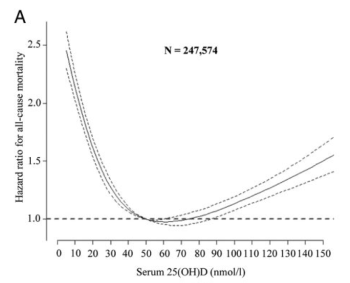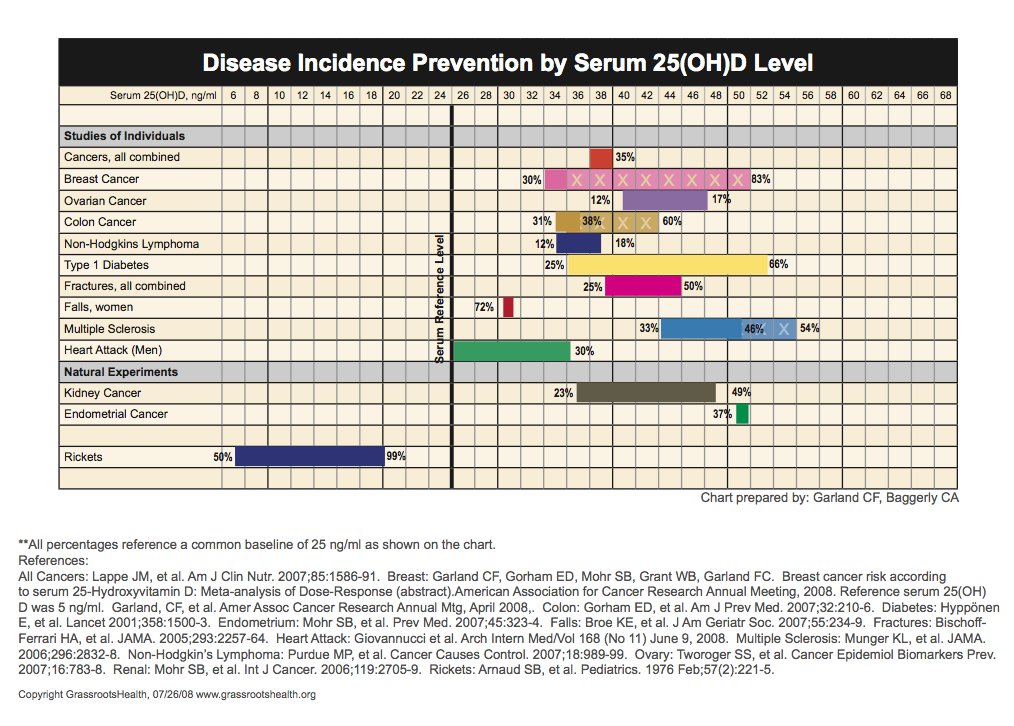Related articles: Mistaking correlation for causation in vitamin D studies, Incidence and prevalence of chronic disease

This is an old revision of the document!
Diseases associated with low levels of 25-D
According to the Marshall PathogenesisA description for how chronic inflammatory diseases originate and develop., chronic inflammatory disease is caused by a microbiotaThe bacterial community which causes chronic diseases - one which almost certainly includes multiple species and bacterial forms. of pathogens which interfere with proper functioning of the innate immune system. Patients suffering from inflammatory diseases have been shown to have lower than normal levels of 25-hydroxyvitamin D, and there are at least several reasons why bacterial pathogens generate this response.
- When the immune system is challenged by pathogens, the body activates CYP27B1, causing more 25-DThe vitamin D metabolite widely (and erroneously) considered best indicator of vitamin D "deficiency." Inactivates the Vitamin D Nuclear Receptor. Produced by hydroxylation of vitamin D3 in the liver. to be converted to 1,25-DPrimary biologically active vitamin D hormone. Activates the vitamin D nuclear receptor. Produced by hydroxylation of 25-D. Also known as 1,25-dihydroxycholecalciferol, 1,25-hydroxyvitamin D and calcitirol..
- When bacterial ligands block the Vitamin D ReceptorA nuclear receptor located throughout the body that plays a key role in the innate immune response., the Receptor is prevented from transcribing CYP24A1, a well-studied enzyme which breaks down excess 1,25-D.
A full understanding of vitamin D metabolism supports the conclusion that elevated 1,25-D and depressed 25-D are a result rather than a cause of the inflammatory process.
Lower than normal levels of 25-D have been independently associated both with all-cause mortality1) 2) and a number of chronic inflammatory diseases. The following selection of diseases (and patient groups) have been observed to display the hallmarks of this kind of dysregulated vitamin D metabolism.
- acute respiratory tract infections 3)
- Addison's disease 4)
- aging skin5)
- alcoholism 6)
- Alzheimer's disease 9)
- asthma 10)
- cancers 11)
- cerebral palsy 24)
- chronic liver disease 25)
- Chronic obstructive pulmonary disease 26)
- congestive heart failure 29)
- connective tissue-associated interstitial lung diseases30)
- Crohn's disease 31)
- cystic fibrosis 32)
- diabetes, type I 38)
- epilepsy 41)
- Graves' disease 42)
- kidney disease 43)
- heart failure44)
- HIV 45)
- inflammatory bowel disease 46)
- metabolic syndrome49)
- myocardial infarction (heart attack) 52)
- osteoporosis and osteopenia 58)
- Parkinson's disease 61)
- pelvic floor disorders 62)
- schizophrenia 63)
- slow psychomotor processing speed 64)
- stroke 65)
- tuberculosis 66)
- undifferentiated connective tissue disease 67)
- vaginosis68)
Anomalies
- mortality in the Danish population – A 2012 study of 247,574 subjects found that both lower and higher levels of 25-D were associated with an increased likelihood of mortality (right).69)
- U-shaped relationship between vitamin D levels and long-term outcome. – In a 5 year follow-up of survivors of acute myocardial infarction patients with vitamin D<10ng/mL and >30ng/mL had higher mortality rate than those with intermediate values. 70)
- risk of breast cancer – In a 2011 study of nurses who were predominantly premenopausal, circulating 25-D levels were not significantly associated with breast cancer risk.
- risk of prostate cancer – In a 2008 nested case-control study appearing in Journal of the National Cancer Institute, Ahn et al. found that patients with the lowest levels of 25-D also had the lowest risk of prostate cancer.71)
- risk of pancreatic cancer – Patients with the highest levels of 25-D were at greatest risk of pancreatic cancer.72)
- some rarer cancers73) – non-Hodgkin lymphoma or cancers of the endometrium, esophagus, stomach, kidney, ovary and pancreas
- cancer mortality – A 2010 longitudinal study found that both high and low concentrations of plasma 25(OH)D were associated with elevated risks of overall and cancer mortality, and low concentrations are associated with cardiovascular mortality.74)
- neonatal vitamin D status and risk of schizophrenia – Danish neonates with the highest measurable levels of 25-D had a two-fold elevated risk of developing schizoprhenia. Based on this analysis, the population-attributable fraction associated with neonatal vitamin D status was 44%. The relationship was not explained by a wide range of potential confounding or interacting variables.75) This study is consistent with the explanation that higher rates of disease were caused by the immunosuppressive effects of heavy supplementation with vitamin D.
- atrial fibrillation – According to results shared at a 2012 conference, patients with 25-D levels above 100 nanograms per 100ml, were 2.5 times more likely to have atrial fibrillation as those with more moderate levels (41-80ng/100ml).
- atherosclerosis in African Americans – Vitamin D is widely used to treat patients with osteoporosis and/or low vitamin D levels based on a medically accepted normal range. This “normal” range is typically applied to all race groups, although it was established predominantly in whites. It is thought that as low vitamin D levels rise to the normal range with supplementation, protection from bone and heart disease (atherosclerosis) may increase, as well. Blacks generally have lower vitamin D levels than whites, partly because their darker skin pigmentation limits the amount of the vitamin produced by sunlight. “Despite” these lower vitamin D levels and dietary calcium ingestion, blacks naturally experience lower rates of osteoporosis and have far less calcium in their arteries. Studies further reveal that black patients with diabetes have half the rate of heart attack as whites, when provided equal access to health care. A 2010 study (explained here) determined the relationship between circulating vitamin D levels and arterial calcium in 340 black men and women with type 2 diabetes.76) The team concluded that higher circulating levels of 25-D in blacks were associated with higher levels of calcified atherosclerotic plaque.



